Using the Forestry Reclamation Approach for Reclaimed Surface Mineland in the Western Gulf: Effects on Pinus taeda Seedling Growth and Survival
Abstract
1. Introduction
2. Materials and Methods
2.1. Study Area
2.2. Experimental Design
2.3. Site Preparation
2.4. Data Collection
2.4.1. Soil Sampling
2.4.2. Vegetation Sampling
2.5. Statistical Analysis
3. Results
3.1. Soil Properties
3.1.1. Physical
3.1.2. Chemical
3.2. Tree Seedlings
3.3. Ecophysiological Variables
3.3.1. Water Potential
3.3.2. Leaf-Level Gas Exchange
3.4. Herbaceous Cover and Density
4. Discussion
4.1. Soil
4.1.1. Physical Properties
4.1.2. Chemical Properties
4.2. Vegetation
4.2.1. Herbaceous Cover and Density
4.2.2. Leaf-Level Measurements
4.2.3. Tree Seedlings
5. Conclusions
Author Contributions
Funding
Data Availability Statement
Acknowledgments
Conflicts of Interest
References
- U.S. Department of Energy, Energy Information Administration. EIA. Annual Coal Report 2020. Available online: https://www.eia.gov/coal/annual/ (accessed on 7 May 2021).
- Angel, P.N.; Burger, J.A.; Davis, V.M.; Barton, C.D.; Bower, M.; Eggerud, S.D.; Rothman, P. The forestry reclamation approach and the measure of its success in Appalachia. Proc. Am. Soc. Min. Reclam. 2009, 20091, 18–36. [Google Scholar]
- Burger, J. Sustainable mined land reclamation in the eastern US coalfields: A case for an ecosystem reclamation approach. In Proceedings of the National Meeting of the American Society of Mining and Reclamation, Bismark, ND, USA, 11–16 June 2011; pp. 113–141. [Google Scholar]
- Angel, H.Z.; Stovall, J.P.; Williams, H.M.; Farrish, K.W.; Oswald, B.P.; Young, J.L. Surface and Subsurface Tillage Effects on Mine Soil Properties and Vegetative Response. Soil Sci. Soc. Am. J. 2018, 82, 475–482. [Google Scholar] [CrossRef]
- Rodrigue, J.A.; Burger, J.A. Forest Soil Productivity of Mined Land in the Midwestern and Eastern Coalfield Regions. Soil Sci. Soc. Am. J. 2004, 68, 833–844. [Google Scholar] [CrossRef]
- Angel, P.N.; Graves, D.H.; Barton, C.; Warner, R.C.; Conrad, P.W.; Sweigard, R.J.; Agouridis, C. Surface mine reforestation research: Evaluation of tree response to low compaction reclamation techniques. Proc. Am. Soc. Min. Reclam. 2006, 2006, 45–58. [Google Scholar]
- Hons, F.M. Chemical and Physical Properties of Lignite Spoil Material and Their Influence upon Successful Reclamation; Texas A&M University: College Station, TX, USA, 1978. [Google Scholar]
- NOAA. 1981–2010 Normals: Carthage, TX; US Department of Commerce, National Centers for Environmental Information: Asheville, NC, USA, 2018.
- Toups, B.G. Comparison of Site Quality for Loblolly Pine on Selected Mined and Non-mined Soils in Panola County, Texas. Master’s Thesis, Stephen F. Austin State University, Nacogdoches, TX, USA, 1986. [Google Scholar]
- Mehlich, A. Mehlich 3 soil test extractant: A modification of Mehlich 2 extractant. Commun. Soil Sci. Plant Anal. 1984, 15, 1409–1416. [Google Scholar] [CrossRef]
- Blake, G.R.; Hartge, K.H. Bulk Density. In Methods of Soil Analysis; 1986; pp. 363–375. Available online: https://doi.org/10.2136/sssabookser5.1.2ed.c13 (accessed on 25 June 2021).
- Bradford, J.M. Penetrability. In Methods of Soil Analysis; 1986; pp. 463–478. Available online: https://doi.org/10.2136/sssabookser5.1.2ed.c19 (accessed on 25 June 2021).
- Bouyoucos, G.J. A Recalibration of the Hydrometer Method for Making Mechanical Analysis of Soils. Agron. J. 1951, 43, 434–438. [Google Scholar] [CrossRef]
- Ginn, S.E.; Seiler, J.R.; Cazell, B.H.; Kreh, R.E. Physiological and Growth Responses of Eight-Year-Old Loblolly Pine Stands to Thinning. For. Sci. 1991, 37, 1030–1040. [Google Scholar] [CrossRef]
- Scholander, P.F.; Bradstreet, E.D.; Hemmingsen, E.A.; Hammel, H.T. Sap Pressure in Vascular Plants: Negative hydrostatic pressure can be measured in plants. Science 1965, 148, 339–346. [Google Scholar] [CrossRef] [PubMed]
- Daubenmire, R. A canopy-coverage method of vegetation analysis. Northwest Sci. 1959, 33, 39–64. [Google Scholar]
- Miller, R.E.; Colbert, S.R.; Morris, L.A. Effects of Heavy Equipment on Physical Properties of Soils and on Long-term Productivity: A Review of Literature and Current Research; NCASI: Cary, NC, USA, 2004. [Google Scholar]
- Scott, D.A.; Burger, J.A. Longleaf and loblolly pine seedlings respond differently to soil compaction, water content, and fertilization. Plant Soil 2014, 375, 255–265. [Google Scholar] [CrossRef]
- Priest, J.S.; Stovall, J.P.; Coble, D.W.; Williams, H.M.; Oswald, B.P. Loblolly Pine Site Index on Reclaimed Mineland in East Texas. For. Sci. 2016, 62, 535–545. [Google Scholar] [CrossRef]
- Shrestha, R.K.; Lal, R. Changes in physical and chemical properties of soil after surface mining and reclamation. Geoderma 2011, 161, 168–176. [Google Scholar] [CrossRef]
- Limstrom, G.A. Forestation of Strip-Mined Land in the Central States; US Department of Agriculture: Washington, DC, USA, 1960.
- Lindstrom, M.J.; Voorhees, W.B.; Randall, G.W. Long-Term Tillage Effects on Interrow Runoff and Infiltration. Soil Sci. Soc. Am. J. 1981, 45, 945–948. [Google Scholar] [CrossRef]
- Torbert, J.L.; Burger, J.A.; Daniels, W. Influence of grading intensity on ground cover establishment, erosion, and tree establishment on steep slopes. In Proceedings of the International Land Reclamation and Mine Drainage Conference and Third International Conference in the Abatement of Acid Mine Drainage, Pittsburgh, PA, USA, 24–29 April 1994; pp. 226–231. [Google Scholar]
- Thomas, W.R.; Pelkki, M.H.; Ringe, J.M. Native high value tree reclamation on surface mined spoils in eastern Kentucky. In Proceedings of the 12th Central Hardwood Forest Conference, Lexington, KY, USA, 28 February–2 March 1999; pp. 100–120. [Google Scholar]
- Kelting, D.L.; Burger, J.A.; Patterson, S.C. Early loblolly pine growth response to changes in the soil environment. N. Z. J. For. Sci. 2000, 30, 206–224. [Google Scholar]
- Sutton, R. Soil Properties and Root Development in Forest Trees: A Review; Information report No. OX-413; Forestry Canada, Ontario Region: Sault Ste. Marie, ON, Canada, 1991. [Google Scholar]
- Angel, P.N. A Soil Analysis of the Strip Mine Spoil Bank at Fairfield, Texas. Master’s Thesis, Stephen F. Austin State University, Nacogdoches, TX, USA, 1973. [Google Scholar]
- Dixon, J.; Arora, H.; Hons, F.; Askenasy, P.; Hossner, L. Chemical, physical, and mineralogical properties of soils, mine spoil, and overburden associated with lignite mining. Reclam. Surf. Mined Lignite Spoil Tex. 1980, 10, 13–21. [Google Scholar]
- Ng, J.P.H. Recovery of Carbon and Nitrogen Cycling and Microbial Community Functionality in a Post-lignite Mining Rehabilitation Chronosequence in East Texas. Ph.D. Thesis, Texas A&M University, College Station, TX, USA, 2012. [Google Scholar]
- Holl, K.D. Long-term vegetation recovery on reclaimed coal surface mines in the eastern USA. J. Appl. Ecol. 2002, 39, 960–970. [Google Scholar] [CrossRef]
- Jeldes, I.A.; Drumm, E.C.; Schwartz, J.S. The Low Compaction Grading Technique on Steep Reclaimed Slopes: Soil Characterization and Static Slope Stability. Geotech. Geol. Eng. 2013, 31, 1261–1274. [Google Scholar] [CrossRef][Green Version]
- Miller, J.; Barton, C.; Agouridis, C.; Fogel, A.; Dowdy, T.; Angel, P. Evaluating Soil Genesis and Reforestation Success on a Surface Coal Mine in Appalachia. Soil Sci. Soc. Am. J. 2012, 76, 950–960. [Google Scholar] [CrossRef]
- Sena, K.; Barton, C.; Hall, S.; Angel, P.; Agouridis, C.; Warner, R. Influence of spoil type on afforestation success and natural vegetative recolonization on a surface coal mine in Appalachia, United States. Restor. Ecol. 2015, 23, 131–138. [Google Scholar] [CrossRef]
- Teskey, R.O.; Fites, J.A.; Samuelson, L.J.; Bongarten, B.C. Stomatal and nonstomatal limitations to net photosynthesis in Pinus taeda L. under different environmental conditions. Tree Physiol. 1986, 2, 131–142. [Google Scholar] [CrossRef]
- Kozlowski, T.T. Soil Compaction and Growth of Woody Plants. Scand. J. For. Res. 1999, 14, 596–619. [Google Scholar] [CrossRef]
- Wieniarska, J.; Lipecki, J.; Stanek, R.; Kesik, T. Effects of soil compaction due to machinery operation on a raspberry plantation. Fruit Sci. Rep. (Pol.) 1987, 14, 71–78. [Google Scholar]
- Urban, J.; Ingwers, M.W.; McGuire, M.A.; Teskey, R.O. Increase in leaf temperature opens stomata and decouples net photosynthesis from stomatal conductance in Pinus taeda and Populus deltoides x nigra. J. Exp. Bot. 2017, 68, 1757–1767. [Google Scholar] [CrossRef]
- Teskey, R.O.; Bongarten, B.C.; Cregg, B.M.; Dougherty, P.M.; Hennessey, T.C. Physiology and genetics of tree growth response to moisture and temperature stress: An examination of the characteristics of loblolly pine (Pinus taeda L.). Tree Physiol. 1987, 3, 41–61. [Google Scholar] [CrossRef] [PubMed]
- Boltz, B.A.; Bongarten, B.C.; Teskey, R.O. Seasonal patterns of net photosynthesis of loblolly pine from diverse origins. Can. J. For. Res. 1986, 16, 1063–1068. [Google Scholar] [CrossRef]
- Ismail, S.M.; Ozawa, K. Improvement of crop yield, soil moisture distribution and water use efficiency in sandy soils by clay application. Appl. Clay Sci. 2007, 37, 81–89. [Google Scholar] [CrossRef]
- Rodrigue, J.A.; Burger, J.A.; Oderwald, R.G. Forest Productivity and Commercial Value of Pre-Law Reclaimed Mined Land in the Eastern United States. North. J. Appl. For. 2002, 19, 106–114. [Google Scholar] [CrossRef]
- Priest, J.; Stovall, J.; Coble, D.; Oswald, B.; Williams, H. Loblolly pine growth patterns on reclaimed mineland: Allometry, biomass, and volume. Forests 2015, 6, 3547–3581. [Google Scholar] [CrossRef]
- Toy, T.J.; Foster, G.R.; Renard, K.G. Soil Erosion: Processes, Prediction, Measurement, and Control; John Wiley & Sons: Hoboken, NJ, USA, 2002. [Google Scholar]
- Burger, J.A.; Evans, D.M. Ripping compacted mine soils improved tree growth 18 years after planting. Proc. Am. Soc. Min. Reclam. 2010, 55–70. [Google Scholar] [CrossRef]
- Carlson, C.; Thomas, R.; Allen, H.L.; Albaugh, T.J.; Stape, J.L.; Rubilar, R.A. Effects of combination plowing on the survival and growth of loblolly pine. Tree Plant. Notes 2014, 57, 18–22. [Google Scholar]
- Norland, M.R. Use of Mulches and Soil Stabilizers for Land Reclamation. Reclam. Drastically Disturb. Lands 2000, 645–666. [Google Scholar] [CrossRef]
- Evangelou, V. Preparation of surface-mined coal spoils and establishment of vegetative cover. AGR-Univ. Ky. Coop. Ext. Serv. (USA) 1981, 89, 1–4. [Google Scholar]
- RCT. Martin Lake Mine Permit 4J Renewal/Revision; Surface Mining and Reclamation Division: Austin, TX, USA, 2009; pp. 1–15.
- Lincoln, M.C.; Will, R.E.; Morris, L.A.; Carter, E.A.; Markewitz, D.; Britt, J.R.; Cazell, B.; Ford, V. Soil change and loblolly pine (Pinus taeda) seedling growth following site preparation tillage in the Upper Coastal Plain of the southeastern United States. For. Ecol. Manag. 2007, 242, 558–568. [Google Scholar] [CrossRef]
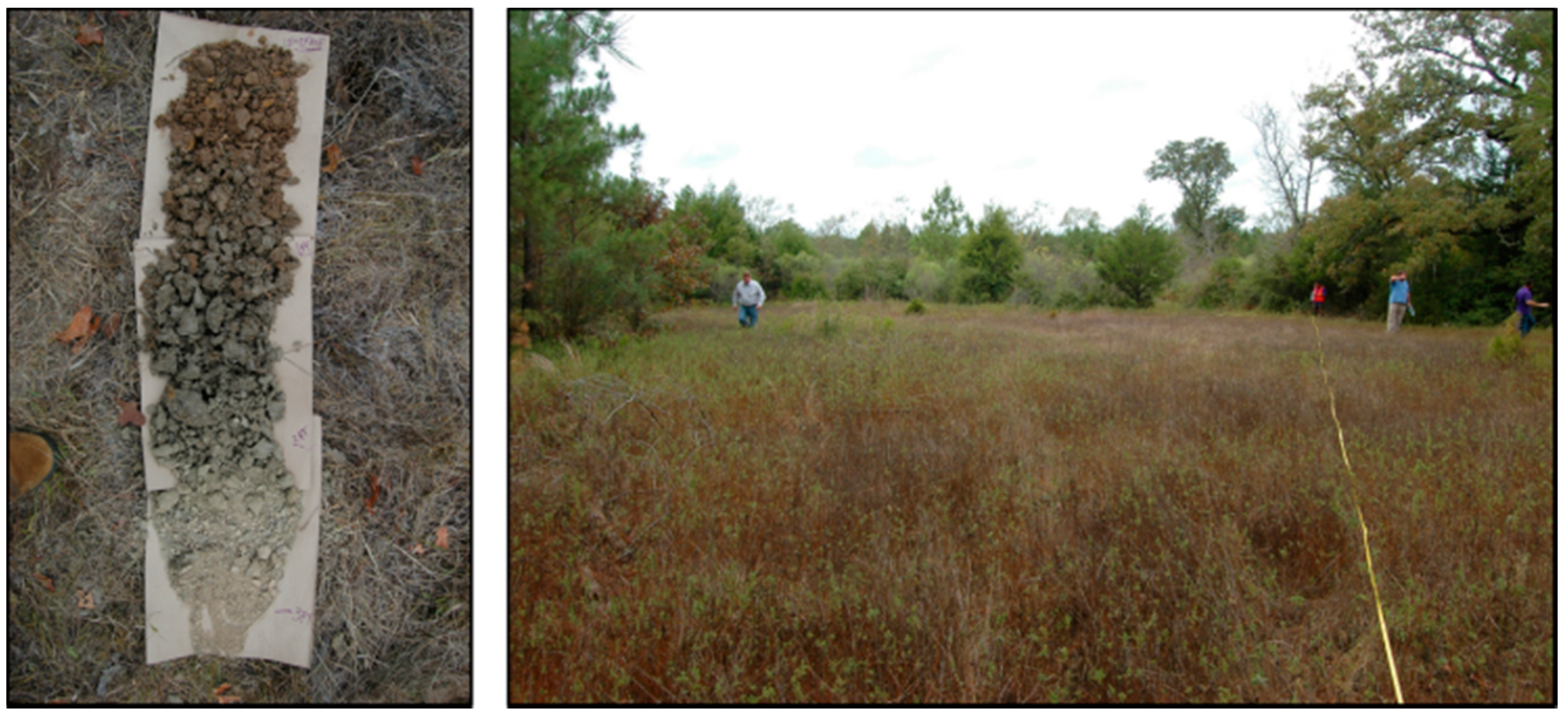
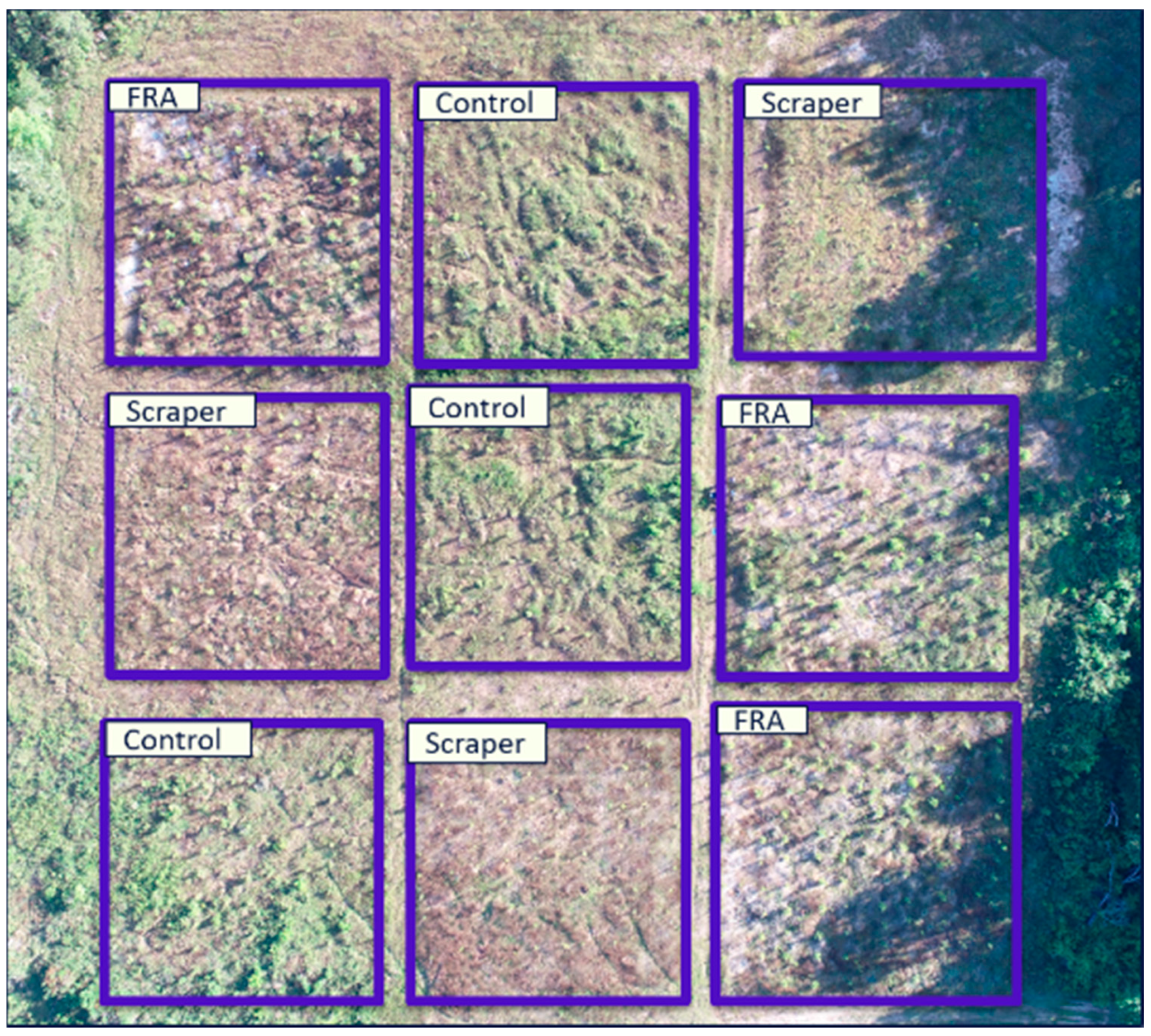
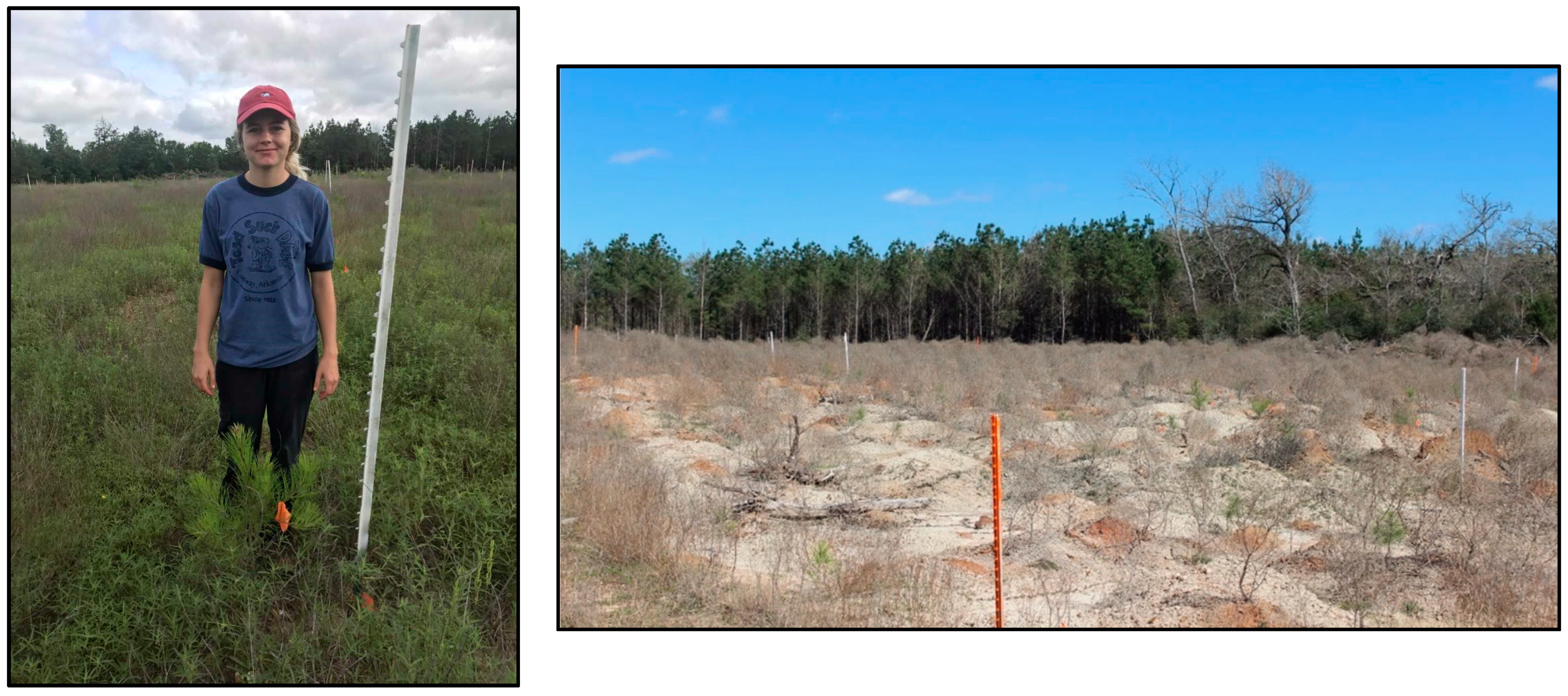
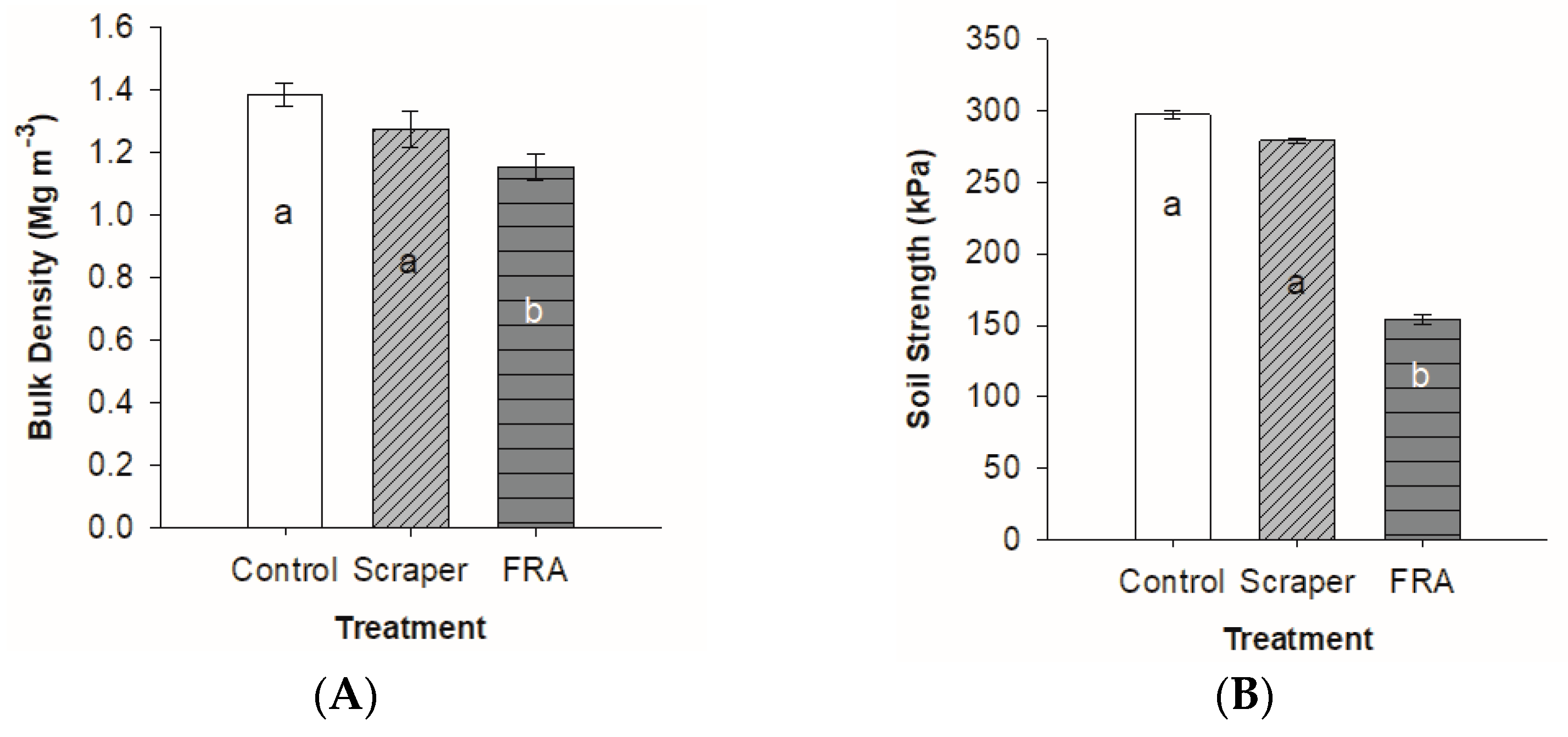
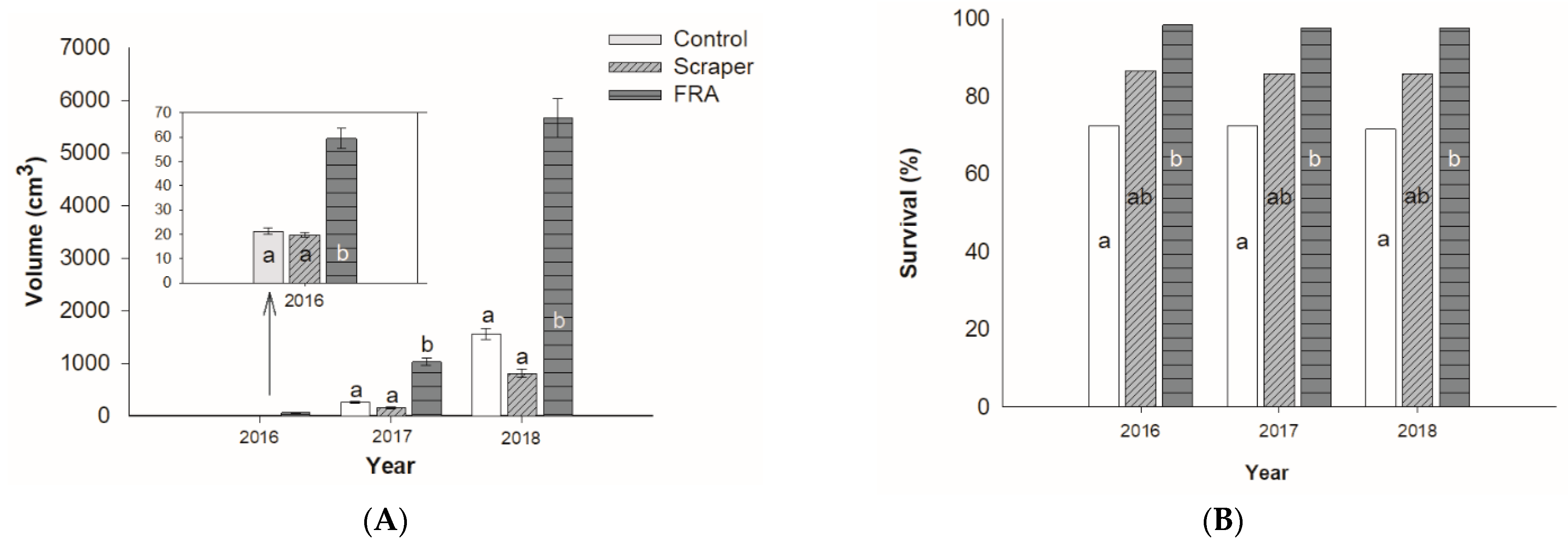
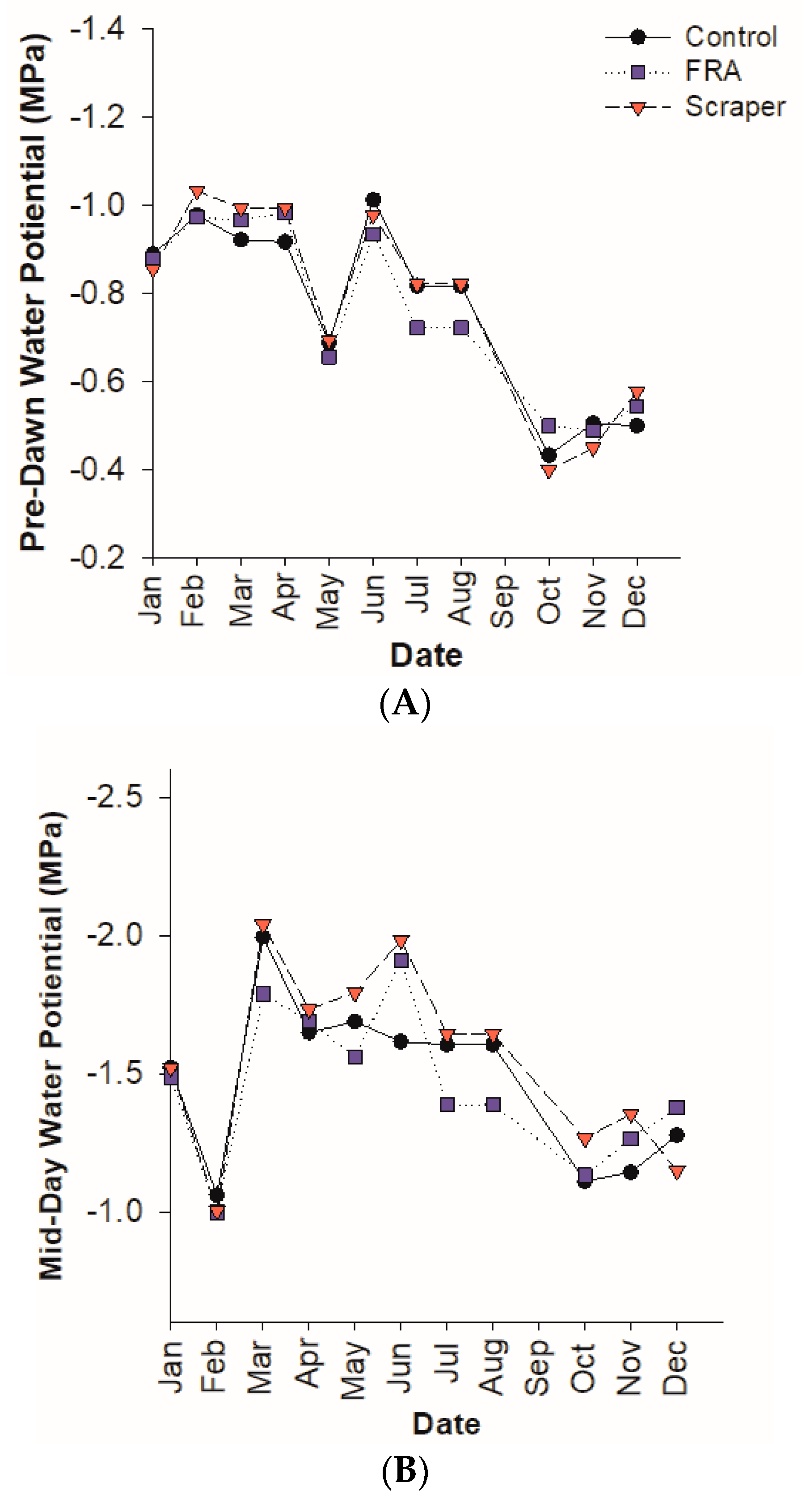
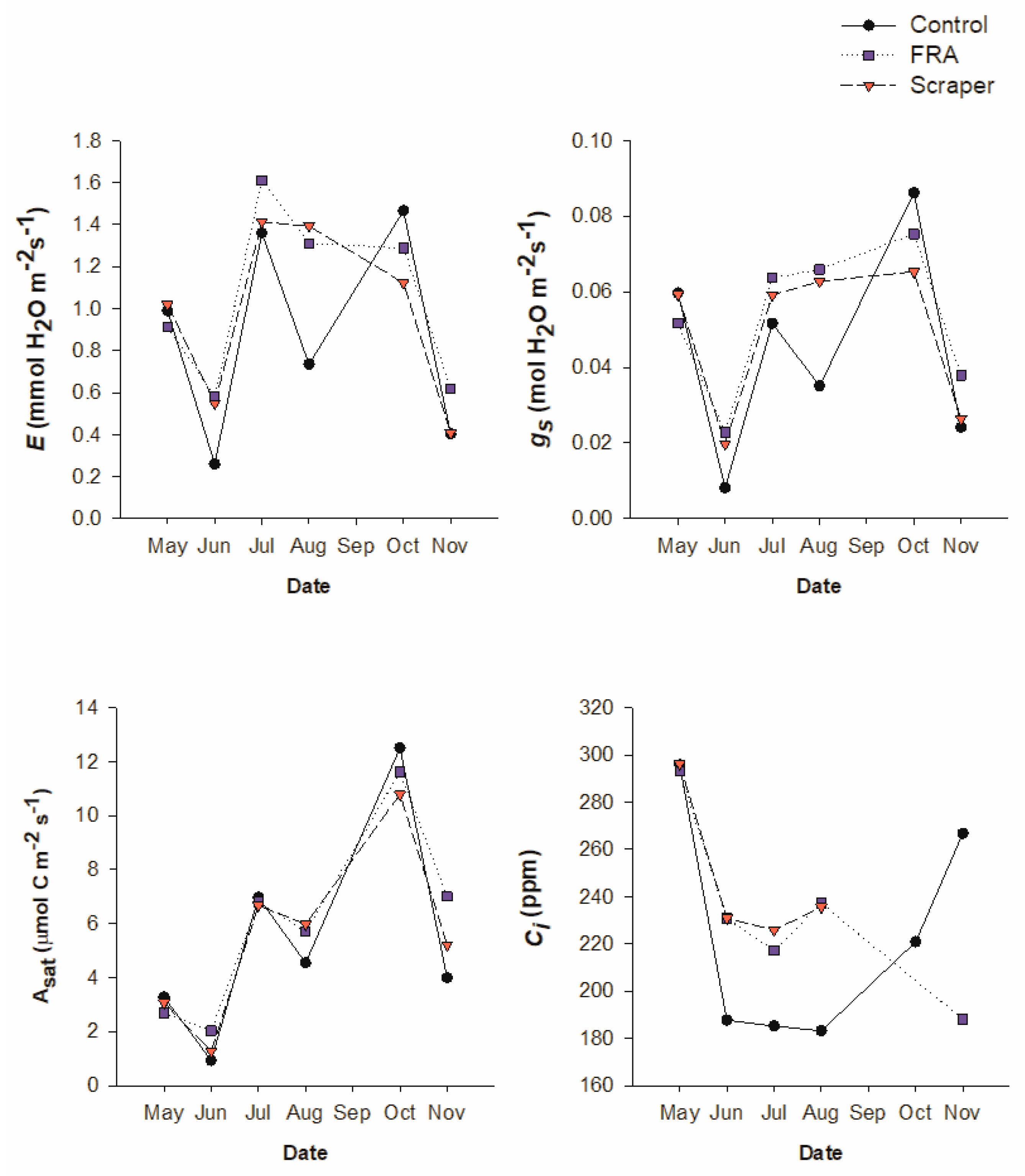
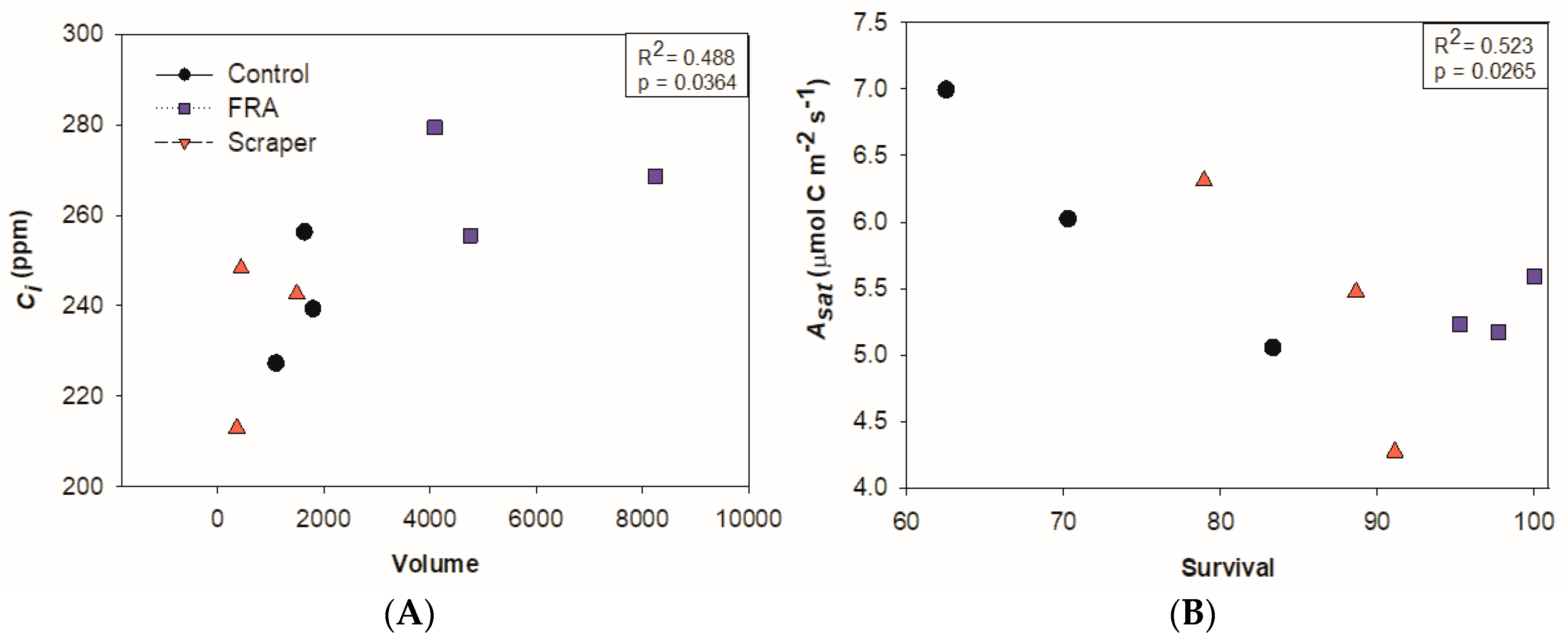
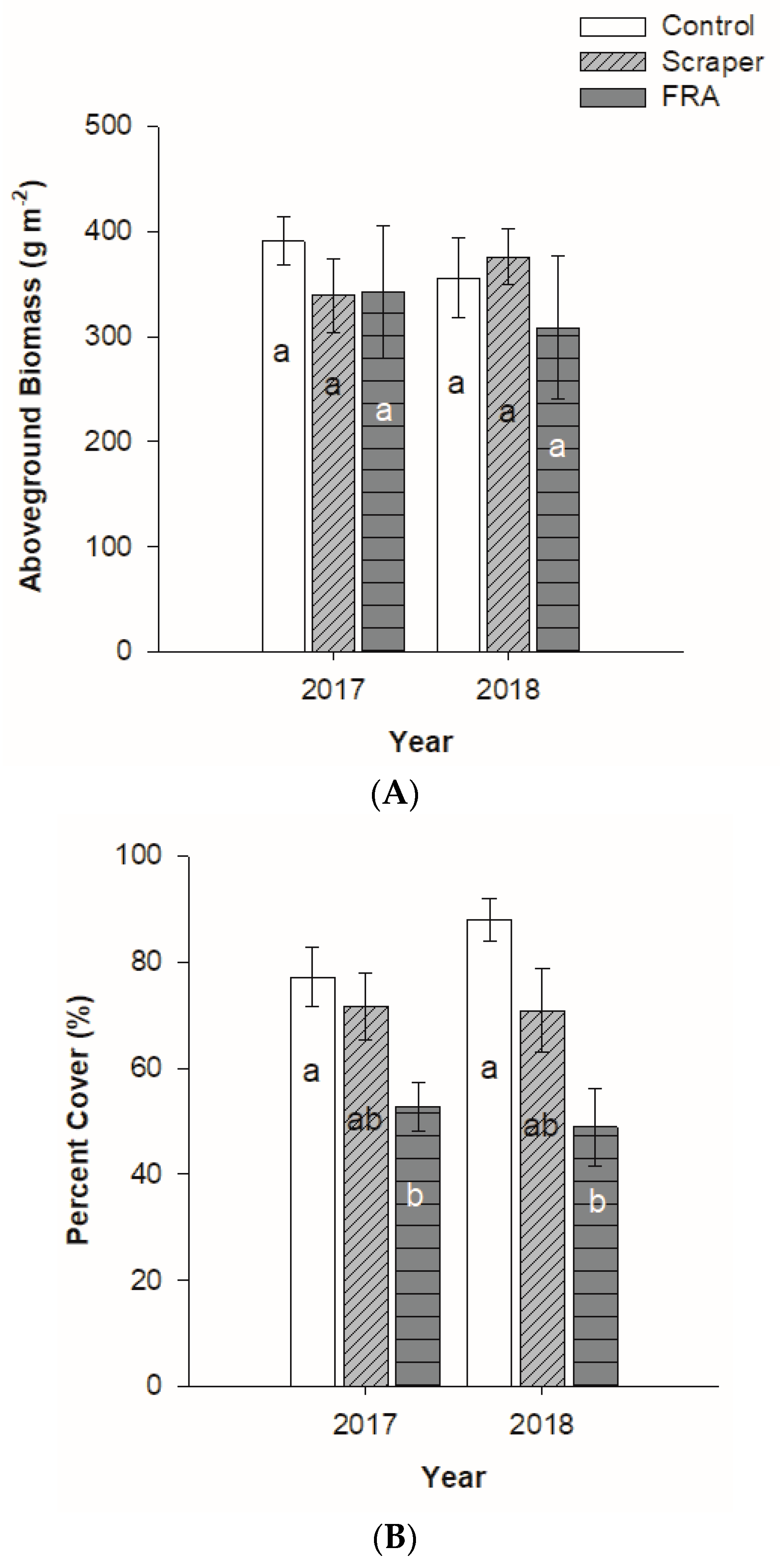
| Treatment | Sand | Silt | Clay | Texture |
|---|---|---|---|---|
| -------------------%---------------- | ||||
| Control | 36a 1 | 26 | 38a | clay loam |
| (1.9) | (2.5) | (3.0) | ||
| Scraper | 28ab | 22 | 50b | Clay |
| (3.4) | (3.2) | (2.6) | ||
| FRA | 21b | 26 | 53b | Clay |
| (2.0) | (3.4) | (1.9) | ||
| Volumetric Water Concentration | |||
|---|---|---|---|
| Date | Control | Scraper | FRA |
| ------------------- m3 m−3------------------- | |||
| January | 0.29 | 0.32 | 0.29 |
| February | 0.36 | 0.33 | 0.30 |
| March | 0.27 | 0.33 | 0.30 |
| April | 0.35 | 0.31 | 0.31 |
| May | 0.30 | 0.28 | 0.31 |
| June | 0.17 | 0.25 | 0.24 |
| July | 0.24 | 0.23 | 0.21 |
| August | 0.18 | 0.21 | 0.21 |
| September | N/A | N/A | N/A |
| October | 0.35 | 0.32 | 0.33 |
| November | 0.29 | 0.34 | 0.34 |
| December | 0.37 | 0.34 | 0.35 |
| Treatment | pH | P | K | Ca | Mg | S | Na |
|---|---|---|---|---|---|---|---|
| -------------------------------mg kg−1 ------------------------------ | |||||||
| Control | 5.93 | 7 | 125 | 2826 | 557 | 10 | 214 |
| Scraper | 7.05 | 3 | 120 | 4516 | 691 | 10 | 273 |
| FRA | 7.43 | 3 | 106 | 4453 | 740 | 13 | 445 |
| Treatment | Year | Height (cm) | Diameter (mm) |
|---|---|---|---|
| Control | 36.07 a1 | 7.32 a | |
| (0.584) | (0.184) | ||
| Scraper | 2016 | 35.27 a | 7.17 a |
| (0.542) | (0.171) | ||
| FRA | 43.06 b | 10.71 b | |
| (1.008) | (0.31) | ||
| Control | 76.58 a | 16.78 a | |
| (1.851) | (0.468) | ||
| Scraper | 2017 | 63.15 a | 13.72 a |
| (1.916) | (0.446) | ||
| FRA | 114.54 b | 27.01 b | |
| (2.873) | (0.778) | ||
| Control | 147.36 a | 30.28 a | |
| (3.215) | (0.794) | ||
| Scraper | 2018 | 114.50 a | 22.36 a |
| (4.005) | (0.826) | ||
| FRA | 211.92 b | 46.93 b | |
| (5.17) | (1.317) |
| Year | Slope Location | Volume (cm3) | Number of Trees |
|---|---|---|---|
| 1 | 65.64 | 13 | |
| 2016 | 2 | 46.51 | 25 |
| 3 | 63.01 | 35 | |
| 4 | 61.56 | 51 | |
| 1 | 1292.37 | 13 | |
| 2017 | 2 | 967.44 | 24 |
| 3 | 961.33 | 35 | |
| 4 | 1037.05 | 51 | |
| 1 | 5660.95 | 31 | |
| 2018 | 2 | 5256.46 | 18 |
| 3 | 5448.56 | 26 | |
| 4 | 5916.9 | 48 |
| Effects | Volume | Survival |
|---|---|---|
| Treatment | 0.1644 | 0.1886 |
| Pre-dawn | 0.1964 | 0.3055 |
| Treatment*Pre-dawn | 0.1876 | 0.1959 |
| Treatment | 0.1605 | 0.5738 |
| Mid-day | 0.3352 | 0.6684 |
| Treatment*Mid-day | 0.3407 | 0.5727 |
| Effects | Pre-Dawn | Mid-Day |
|---|---|---|
| gs | 0.2411 | 0.9719 |
| Asat | 0.0705 | 0.6546 |
| Ci | 0.4671 | 0.8223 |
| E | 0.2358 | 0.6860 |
| Volume | ||||
| Variable | P | R | β0 | β1 |
| E | 0.797 | 0.100 | 1.008 | 5.79 × 10−6 |
| Ci | 0.036 | 0.698 | 233.274 | 0.005 |
| gs | 0.887 | −0.056 | 0.051 | −1.79 × 10−7 |
| Asat | 0.525 | −0.245 | 5.769 | −7.5 × 10−5 |
| Survival | ||||
| Variable | P | R | β0 | β1 |
| E | 0.133 | −0.541 | 1.562 | −0.006 |
| Ci | 0.379 | 0.335 | 202.471 | 0.532 |
| gs | 0.066 | −0.636 | 0.085 | −4.0 × 10−4 |
| Asat | 0.027 | −0.727 | 9.417 | −0.045 |
Publisher’s Note: MDPI stays neutral with regard to jurisdictional claims in published maps and institutional affiliations. |
© 2021 by the authors. Licensee MDPI, Basel, Switzerland. This article is an open access article distributed under the terms and conditions of the Creative Commons Attribution (CC BY) license (https://creativecommons.org/licenses/by/4.0/).
Share and Cite
Phillips, C.; Stovall, J.; Williams, H.; Farrish, K. Using the Forestry Reclamation Approach for Reclaimed Surface Mineland in the Western Gulf: Effects on Pinus taeda Seedling Growth and Survival. Forests 2021, 12, 845. https://doi.org/10.3390/f12070845
Phillips C, Stovall J, Williams H, Farrish K. Using the Forestry Reclamation Approach for Reclaimed Surface Mineland in the Western Gulf: Effects on Pinus taeda Seedling Growth and Survival. Forests. 2021; 12(7):845. https://doi.org/10.3390/f12070845
Chicago/Turabian StylePhillips, Cassie, Jeremy Stovall, Hans Williams, and Kenneth Farrish. 2021. "Using the Forestry Reclamation Approach for Reclaimed Surface Mineland in the Western Gulf: Effects on Pinus taeda Seedling Growth and Survival" Forests 12, no. 7: 845. https://doi.org/10.3390/f12070845
APA StylePhillips, C., Stovall, J., Williams, H., & Farrish, K. (2021). Using the Forestry Reclamation Approach for Reclaimed Surface Mineland in the Western Gulf: Effects on Pinus taeda Seedling Growth and Survival. Forests, 12(7), 845. https://doi.org/10.3390/f12070845





